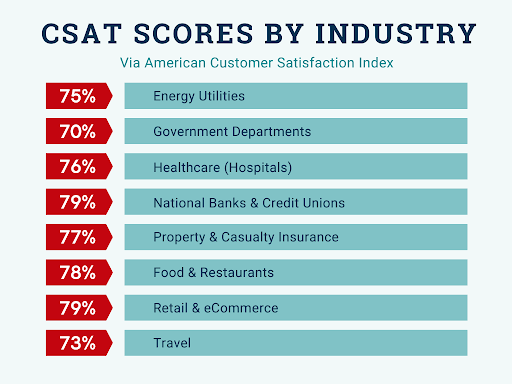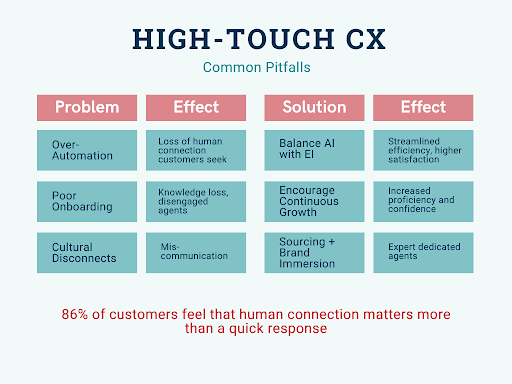Read Time: 16 minutes
Table of Contents
Introduction
High-touch customer experience management is when high-value customers receive personalized support with a customer success manager.
In today’s increasingly remote and digital-first world, delivering a high-touch customer experience requires more than just friendly service—it demands intentional strategy, empathetic communication, and the right technological infrastructure. Gone are the days when outsourcing equated to impersonal service. A high-touch customer experience approach elevates service, effectively engaging customers and yielding powerful results.
This article explores how companies can maintain and even enhance personalized customer care while managing remote teams and leveraging outsourcing solutions. From guided onboarding to AI-powered insights, you’ll learn how to build a scalable, high-touch CXM model that keeps customers engaged and loyal.
Key takeaways
- High-touch customer experience management (CXM) is achievable and scalable with remote, dedicated teams.
- Success in outsourced CXM hinges on strategy, alignment, communication, and continuous improvement.
- Outsourcing should be viewed as a value-generating partnership, not merely a cost-saving tactic.

Understanding high-touch CXM in the age of remote teams
How customers feel about your company—and the action they take with it—depends on the care they receive when making or resolving issues with products or services.
As many as 73% of consumers say that CX is a deciding factor when making purchase decisions, and 96% of customers believe that customer experience is a key aspect of brand loyalty.
As a result, offering excellent dedicated care is key to attracting and retaining customers.
High-touch customer experience may seem straightforward enough in person with the ability to build relationships with customers, but applying it to remote teams is tricky without the proper strategies and infrastructure to empower agents to provide the level of attention that successfully engages customers.
In this article, we break down the key steps to doing so to push your customer care and your business ahead of the game.
What is high-touch CXM?
First;
It’s important to understand the distinctions between regular customer support and high-touch CXM.
High-touch customer experience is the personalized service a support team gives to high-value customers at each stage of the customer journey.
High-touch CXM includes getting to know your customers, engaging with empathy, and using data to proactively anticipate issues and provide solutions to resolve them before they escalate.
But what does this look like in your management strategies?
Try breaking up high-touch CX in these ways:
- A guided onboarding process
- A dedicated customer success manager for each client
- Individual strategy sessions
- Regularly scheduled check-ins
- Personalized, conversational service across multiple channels with empathetic agents who can access all relevant information
Personalized support uses historical data to tailor interactions to meet the individual’s needs and preferences.
Companies today are using call center sentiment analysis to better understand feelings and moods customers have toward businesses and the active support they receive.
Key to de-escalating tense interactions, empathetic support helps customers feel seen and heard, even over the phone, through simple active listening.
A high-tech CX strategy powers all these initiatives.
High-tech CX includes integrating cutting-edge technologies that streamline operations while providing tools for more custom support.
These platforms use machine learning to better understand human language and implement automations, interaction tracking, and data analytics to drive significant results, including improvements in handling time, errors, and customer satisfaction.
Why high-touch CX matters in a digital, global economy
Customers seek personalized service, even in their digital interactions.
According to a study by Forbes, customers want businesses to know them: 81% of customers prefer companies that offer a personalized experience, and 70% say a personalized experience in which an employee knows who they are and their history with the company is important.
A customer-centric business strategy applies to both B2C and B2B and contexts.
Business-to-customer:
Putting the customer first gives your business the powerful advantage of a loyal customer base who will stick with you despite the flashy offerings of your competitors—and it will pay off in the long run. Attracting customers can cost up to five times more than it costs to retain a customer.
Business-to-business:
Running operations requires sourcing products and services from other supply companies, and building and maintaining these relationships requires just as much care as your customer support initiatives. Whether you interact with these businesses face-to-face or virtually, high-touch CX will show you respect the relationship and value them as mutually beneficial partners with a unified goal and vision of success.
Rethinking outsourcing: From cost-cutting to CX excellence
Providing this level of dedicated care in-house is difficult, if not impossible, as your business grows. Internal teams still need to run daily operations as they interact with in-person customers at various stages of the customer journey, requiring multiple skillsets and different levels of attention.
Especially during busy seasons or unexpected demand surge, customers seeking attention virtually can fall by the wayside as staff struggle to keep up.
In comes outsourcing to save the day!
While many turn to outsourcing as a way to reduce overall business costs—and it does significantly reduce operational and overhead costs—strategic outsourcing can also enhance CX in key ways:
Outsourcing accesses customer experience experts worldwide
Customer support hubs in Mexico, the Philippines, South Africa, Tunisia, and the US train agents not only in customer support best practices, but also in various industries.
By outsourcing, you can dip into these constantly updated agent pools for the rapid hiring of experts ready to onboard.
Outsourced dedicated agents provide personalized support
Dedicated support agents work only for your business, immersing in your brand culture and values to better represent your company.
As a face of your business, they can focus on developing customer support relationships with the level of high-touch care you want for loyal customers while your internal staff focuses on daily operations.
Data-driven technology streamlines processes while providing real-time insights
Outsourcing with the right contact center partner equips your business with cutting-edge technology that marries efficiency with connection.
Platforms should integrate seamlessly with your internal systems to enhance operations while providing key strategies to analyze and act on analytics for performance improvement.
Leverage Voice of the Customer insights to revolutionize your customer experience management.
Outsourcing makes your business scalable
One of the biggest motivators for modern outsourcing, scalability ensures your company can adequately staff to provide customers with the level of attention they desire, no matter how busy or slow the demand is.
This offers vital perks for business and customer success:
- Cost-efficiency: Reduce overhead and staffing costs while acting on opportunities for increased engagement, including upselling and cross-selling.
- Reduced overwhelm: Provide 24/7 support via chatbots, enhanced self-service, and agents sourced during or outside of your business hours.
- Reduced customer churn and employee attrition: Dedicated care improves customer and employee satisfaction and loyalty, reducing time and resources spent attracting new customers or training new hires.
- Urgent hiring capabilities: When you need staffing fast, outsourced agents meet the timeline. Efficient training technology reduces onboarding and nesting while boosting speed to proficiency and confidence.
Want to scale your business?
Global Response has a long track record of success in outsourcing customer service and call center operations. See what our team can do for you!
Building a high-touch CXM model with remote teams
Transforming your support with a high-touch approach doesn’t have to be limited to face-to-face interactions.
Help your teams provide personalized service by following an organized strategy.
To help you along, we’ve broken it down into five key steps.
Step 1: Defining and mapping customer journeys
Understanding the customer journey is of utmost importance to providing your audience with the assistance they need, before they even realize they need it.
Walk through the steps your customers do to identify bugs, opportunities for personalization and self-service, and possible pain points.
Fully capturing these critical turning points in your customer journey mapping will help you more efficiently allocate resources to streamline operations and improve customer satisfaction.
Outsourcing’s effect on journey mapping: Partnering with a third party will give you a fresh set of eyes to better grasp pain points and best practices to solve them, as well as new ideas that can revolutionize your care.
Step 2: Selecting the right dedicated outsourcing partner
Choosing a high-quality partner to outsource your remote customer support teams will drive the success you seek for your CX strategy.
What makes a BPO the right remote CX team for you depends on a variety of factors, but we think the most essential requirement is a partner who aligns with your brand values.
Brand value alignment can mean multiple things, whether it’s the explicit values you live by and display on your website or the overarching goals of all business operations.
Ask yourself these questions to determine your most important values:
- Are you a family business seeking similar perspectives from a BPO?
- Do you prioritize efficiency above engagement?
- What do you want operations to look like as you utilize artificial intelligence and agent expertise?
- What makes you stand out as a business? What makes your potential BPO partners stand out?
- What do you want your customers to get out of high-touch customer service?
Your answers to these questions will inform the type of partner you seek.
While you should customize your criteria for choosing a partner aligned with your brand values, you should be sure to include these factors:
- Cost-efficiency
- Technology-forward while maintaining valuable agent expertise
- Results-focused, with relevant experience documented and available
- Proactive data-driven strategies
- Authentic culture that accepts feedback
Step 3: Training and brand immersion
Kick off your new CX strategy with comprehensive training programs that will put your remote CX team on the path for success.
With your dedicated outsourcing provider, determine which training strategies suit your customer experience outsourcing plan:
- AI training technologies: Input training materials into a system that uses various types of AI to streamline documentation, gamify learning, and help agents access your knowledge base faster.
- In-person training: Often required for specific compliance regulations, in-person training provides face-to-face assistance and empowers your internal staff to communicate brand-specific knowledge. Simulate this in remote teams by video conferencing or by training in person for a fraction of the training schedule for best use of your resources.
- Simulation-based learning: Available in many AI training platforms, hands-on learning significantly boosts speed to proficiency and agent confidence by providing a safe space for agents to make mistakes and learn best practices based on real situations.
- Brand immersion: Immersing agents in your brand culture and product education enables them to reflect the voice of your company and empowers them to expertly aid customers, infectiously sharing the values and passions that drive customer loyalty.
Whatever combination of these strategies you choose, customized learning will lead to better performance and clearly stated expectations.
Remember to train for remote leadership to more effectively support your agents and provide continuous cohesive support across channels.
Step 4: Communication protocols and real-time collaboration tools
Communication and collaboration go hand-in-hand in successfully leading your remote CX team through their high-touch customer service efforts.
Work with your outsourced contact center to choose the right tools and protocols to follow, but get inspired with these ideas.
Communication protocols:
- Standard Operating Procedures (SOPs) outlining specific steps and best practices for agents to follow during customer interactions
- Agent scripts for unified brand voice and de-escalation assistance
- Data privacy compliance and proactive measures to flag and reduce errors
- Escalation workflows clearly established, with tips for resolving issues
- Regular custom reporting and continuous agent coaching
Real-time collaboration tools:
- CollaborationRoom.AI keeps video eyes on agents and teams as if they are in the office. AI technology tracks facial expressions, body language, and tone to discern moods, providing leaders with opportunities to offer real-time assistance.
- Playvox workforce management precisely forecasts staffing and provides real-time performance insights, allowing businesses to leverage AI in automations and quality management.
- Various telephony platforms, such as Five9, NICE, and Talkdesk, integrate seamlessly with your CRM and offer advanced features to enhance the customer experience.
Leading technology will facilitate effective communication and collaboration between team members, team leaders, and customers for a comprehensive and effective high-touch customer service strategy.
Step 5: Performance monitoring and feedback loops
A leading reason AI is taking the contact center industry by storm is its effectiveness in measuring key performance metrics of all customer interactions.
Advanced technologies help you determine effectiveness of solutions through constant performance monitoring and provide actionable insights via feedback loops.
Automated reports seamlessly offer tips for improvement targeted to each agent and customer, using historical and real-time feedback for more accurate insights.
These suggestions evaluate customer sentiments to provide valuable data about the success of your solutions.
Case studies: Businesses that mastered high-touch remote CX
High-touch remote CX is not only possible, but also real and powerful.
Take inspiration and learn valuable lessons from these real-world examples of companies that do high-touch remote CX right.
Apple’s approach to support and service
Famous for its exemplary culture and engaging service, Apple treats every interaction—online, technical support, and store support—as an opportunity to enrich the customer experience.
Amazon’s customer service model
An “obsessive-compulsive focus” on customers
Metrics that matter: How to measure CXM success
Stay proactive about the customer experience by tracking metrics for overall contact center performance and specific metrics tailored to your business and industry.
One important key performance indicator is Average Handling Time, or the average time it takes your agents to handle interactions of a certain type (call, email, text, chat).
Determine the ideal time necessary to handle an interaction by taking into account certain factors:
- Time spent developing relationships
- Time spent providing solutions for simple versus complex requests
- Time spent navigating escalations, including researching issues and de-escalating angry customers
- Call or interaction type
But there’s more to performance than even AHT. Don’t forget these other important KPIs to track how customers feel about their experiences:
Customer Satisfaction (CSAT): Measured in a percentage out of 100% or on a scale of 1 to 5, customer satisfaction scores tell businesses how customers feel about a product, service, or experience.
Determine CSAT via feedback surveys asking customers to rate their satisfaction with specific services on a scale from 1 to 5.
The formula to calculate CSAT is simple:
CSAT = (Number of responses rating 4 or 5 / Total number of responses) x 100
Example: You distribute 100 surveys and receive 80 responses. 50 of those responses are 4s and 5s.
(50 / 80) x 100 = 62.5% CSAT
This is an average CSAT score, but specific benchmarks vary by industry.

Net Promoter Score (NPS): Net Promoter Score measures the customer’s likelihood of recommending a product, service, or organization based on their customer experience.
Determine NPS by asking customers, “On a scale of 0 to 10, how likely are you to recommend this product or company?” at any stage of the customer journey.
First-Call Resolution (FCR): First-call resolution measures the percentage of customer inquiries that are resolved during customers’ first contact with a service representative.
This metric demonstrates the effectiveness of your solutions, and a high FCR rate indicates better customer satisfaction and operational efficiency.
READ MORE: 5 Customer Experience Metrics That Matter Most (and how to track them)
Common pitfalls and how to avoid them

Outsourcing your remote teams doesn’t come without its challenges.
As you navigate each stage of customer experience management, common issues can present themselves, threatening the success of your careful planning.
Equip yourself with the tools to successfully turn these challenges into solutions with these tips.
Problem: Over-automation
Automation is taking the customer support industry by storm, significantly improving not only customer self-service and satisfaction but also operational efficiency and employee satisfaction.
However, relying too much on automation can lead to negative consequences for your business:
- Job displacement
- Loss of human skills
- Loss of emotional connection
- Reduced customer satisfaction
- Data security vulnerabilities
- Difficulty identifying and correcting errors
Solution: Balance AI with EI
Five9 discovered in a survey that 86% of respondents feel that human connection matters more than a quick response.
As powerful as automation is, running customer support operations still requires skilled and empathetic human support.
Customers seek the human touch, so give it to them.
Try these tips to balance artificial intelligence with emotional intelligence:
- Automate routine tasks
- Train agents on routine tasks in the case of tech outages and down-time
- Partner with a contact center expert to maximize your workforce with your demand
- Train agents on soft skills such as empathy, compassion, adaptability, and active listening
- Train agents on problem-solving skills for complex issue and compliance risk resolution
Problem: Poor onboarding
Sometimes it’s impossible to avoid lengthy, complicated training and onboarding programs.
However, the onboarding process sets the stage for how your team operates, navigates challenges, and accesses solutions throughout the rest of the campaign.
Too much focus on memorizing dense material can discourage knowledge retention, and unnecessary onboarding and nesting stages can lead to frustration, disengagement, and early churn.
Solution: Encourage continuous growth
Create a seamless transition from training to onboarding, empowering your agents to confidently engage with customers, by implementing strategies that not only leave room for but encourage growth.
First, create a safe learning space by using hands-on learning with real-world scenarios during training.
This will engage new hires’ critical thinking and problem-solving skills in cases relevant to the future job, allowing them to safely learn from mistakes, increasing speed to proficiency and confidence.
Establish a foundation of trust with your team by clearly communicating expectations.
Engage in regular data-based training sessions to tailor continuous growth suggestions to each individual.
Problem: Cultural disconnects
Without the proper fit, outsourcing runs the risk of disengaging customers.
Gaps in understanding frustrate and confuse both customers and agents, affecting performance metrics and your brand reputation.
Solution: Tailored sourcing and brand immersion
Customer support experts in various onshore, nearshore, and offshore contact center hubs can provide the cultural fit you seek.
A key indicator of culture fit is language skills, but don’t discount the ways outsourced agents in certain countries can exceed your expectations for cultural alignment.
Work with your contact center BPO to discover the right fit for you.
They will know which agent pools to access for specific language, business, and soft skills—and they may even offer training and resources that can improve each.
Of course, sometimes your hands are tied as to which countries you can access.
Invest in the personal and professional growth of your team by cultivating the skills you seek and immersing agents in brand culture to help them adopt your voice.
This will also develop more passion for your products and services, which your customers will feel in turn.
Final thoughts: Humanizing remote CX with strategic outsourcing
Effectively personalizing the customer experience via a remote team is possible and well within your capabilities as you approach the task with a targeted, mindful, comprehensive mindset.
Balancing efficiency with empathy will resonate with your customers as you anticipate their needs and provide exceptional service.
While some view outsourcing as a risk to CX with the possibilities of degrading your high-touch efforts, it actually allows your brand to provide the dedicated care customers expect in a business.
Outsourcing accelerates high-quality CX, engaging meaningfully with your audience and allowing your business to create and cultivate relationships that bring invaluable customer loyalty.
Explore outsourcing solutions that offer the value you want your customers to feel when they reach out for support.
At Global Response, we offer high-touch CX, customized to your business, that catapults companies and customers into immediate and long-term success.
Book a CXM consultation or contact Global Response today to receive a free quote for our exemplary customer care services.




